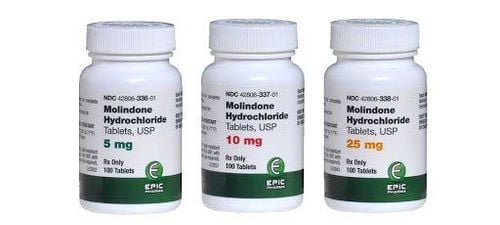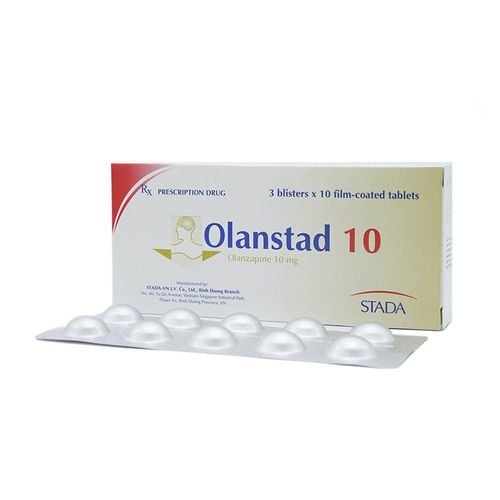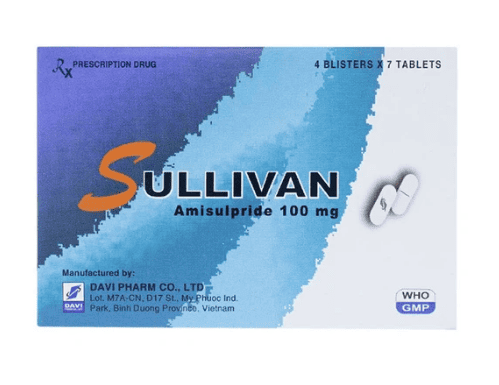This is an automatically translated article.
Gayax is an antipsychotic medication used to help relieve symptoms of acute and chronic schizophrenia. This is a prescription drug, patients need to consult a doctor and learn some information about uses, dosage, and notes when using Gayax in the article below.
1. What is Gayax?
Gayax's active ingredient is Amisulpride 200mg, prepared in tablet form. This is a medication used to treat schizophrenia.
When used, it was found that Amisulpride has a high affinity for dopamine D2/D3 receptors, but no affinity for D1, D4 and D5. Amisulpride also has no affinity for serotonin, alpha-adrenergic, and histamine H1 receptors. At high doses, Amisulpride preferentially induces blockade of dopamine receptors in the limbic structure rather than in the striatum. At lower doses, Amisulpride preferentially blocks presynaptic D2/D3 receptors, causing dopamine release. This property of the drug may explain the clinical effects of the drug on both negative symptoms (usually at low doses) and positive symptoms of schizophrenia (usually at high doses).
2. Uses of the drug Gayax
Gayax is indicated for use in the following cases:
Treatment of acute and chronic schizophrenia with positive symptoms, that is, changes in normal emotions such as delusions, hallucinations, confusion disordered thinking and/or negative symptoms, i.e. decrease or loss of normal emotions such as decreased affectivity, apathy, lack of interest in social life, language impairment... including patients with predominant negative symptoms. Gayax is contraindicated in the following cases:
Patients with hypersensitivity to the active ingredient Amisulpride or any of its ingredients. Prolactin-dependent tumors such as breast cancer, pituitary prolactin tumors. Pheochromocytoma. Children under 15 years old or children before puberty. Pregnant women, lactating women. Women of childbearing potential are not using appropriate contraception. Do not combine with the following drugs because they can cause torsades de pointes, including: Quinidin, Disopyramid, Procainamide, Sultopride, Amiodarone, Sotalol, Bepridil, Cisaprid, Thioridazine, Intravenous Erythromycin, Intravenous Vincamine, Halofantrin, Pentamidine , Sparfloxacin. Do not combine with Levodopa drugs. Patients with renal impairment have a creatinine clearance < 10 mL/min. The product contains lactose, so patients with rare hereditary problems such as galactose intolerance, the Lapp lactase deficiency or glucose-galactose malabsorption should not use it.
3. Usage and dosage of Gayax
How to use:
Swallow the tablet whole with water, do not chew or crush the tablet. The medicine should be taken before meals. Dosage in adults: If the dose is 300 mg/day or less, it should be taken once a day and if the dose is over 300 mg/day, the dose should be divided into 2 times/day.
Patients with positive symptoms in the acute phase: Take 400-800mg/day. In some cases, the dose can be increased to 1200 mg/day. Doses above 1200 mg/day have not been fully evaluated for safety and are therefore not recommended. Dosage should be adjusted according to individual patient response. For patients with both negative and positive symptoms, the dose should be adjusted accordingly for optimal control of positive symptoms. For patients with mostly negative symptoms, a dose of about 50-300mg/day should be used. Adjust dose according to individual patient response. The maintenance dose should be individualized to the individual patient with the lowest effective dose. Elderly:
Amisulpride should be used with caution due to the risk of hypotension and sedation. Dosage may need to be reduced if elderly patients have renal impairment. Children:
This drug is contraindicated in children under 15 years of age (before puberty) due to the lack of data on safety. Patients with renal impairment: Amisulpride is eliminated mainly by the kidneys, so dosage adjustment is required in patients with renal impairment. Patients with creatinine clearance about 30-60mL/min: Take 1/2 dose as prescribed. Patients with creatinine clearance about 10 - 30mL/min: Take 1⁄3 of the dose. Do not use in patients with ClCr < 10 mL/min. Hepatic impairment:
Because this drug is poorly metabolized by the liver, no dose adjustment is necessary. Overdose, missed dose and treatment:
Overdose:
Overdose symptoms such as: Drowsiness, coma, severe hypotension and extrapyramidal symptoms. Fatal cases have often been reported as a result of overdose when used concomitantly with other antipsychotics. Management: Hemodialysis has not been shown to be effective for Amisulpride overdose. There is no specific antidote, so it is necessary to monitor the patient and take appropriate supportive measures. If symptoms of severe extrapyramidal syndrome are present, anticholinergics should be used. Missed dose:
If you forget to take a dose of this medicine, take it as soon as possible. If it is almost time for your next dose, do not take the missed dose, but take it according to the old schedule.
4. Side effects of the drug Gayax
When using Gayax, unwanted effects may occur, including:
Very common side effects: Extrapyramidal symptoms may occur such as tremors, muscle spasms, movement disorders, increased secretions. saliva. These symptoms are usually milder with optimal dose use and partially reversible without discontinuation of Parkinson's medication. The frequency of extrapyramidal symptoms is largely dose dependent, with lower frequencies seen in predominantly symptom-negative patients receiving doses of 50 to 300 mg/day. Common: Acute neuromotor disturbances such as torticollis, convulsions, eye rotation, jaw stiffness, lethargy, insomnia, restlessness, anxiety, constipation, nausea, vomiting, dry mouth, increased concentration prolactin levels are reversible after drug discontinuation, causing increased lactation, amenorrhea, gynecomastia, breast tenderness, male erectile dysfunction, hypotension, weight gain, hypersensitivity reactions; Uncommon: Tardive dyskinesia characterized by rhythmic involuntary movements mainly of the tongue and/or face has been reported, usually occurring after prolonged use (therapeutic drugs). Parkinson's disease is ineffective in this case or may worsen symptoms), convulsions, hyperglycemia, arrhythmias, increased liver enzymes, hypersensitivity reactions. Other: Leukopenia/neutrophils/granulocytopenia, hypertriglyceridemia and hypercholesterolemia, confusion, potentially fatal neuroleptic malignant syndrome, prolongation of the QT interval and ventricular arrhythmias such as arrhythmia, ventricular tachycardia, can also lead to ventricular fibrillation or cardiac arrest, sudden death, angioedema, urticaria, neonatal withdrawal syndrome. Thromboembolic events, including sometimes fatal pulmonary embolism, and cases of deep vein thrombosis have been reported with the use of antipsychotics. When experiencing unwanted effects, you should notify your doctor for reasonable advice.
Need to stop taking the drug and contact the nearest medical center if the following reactions are experienced:
Malignant sedation syndrome including high fever, sweating, muscle spasticity, tachycardia and tachypnea , feeling confused, drowsy, or agitated. Convulsions. Venous thromboembolism with pain in the leg, red hot swelling in the leg...
5. Note when using Gayax
Before using the drug you need to read the instructions carefully, tell your doctor about the history of allergies and other diseases.
When used can also cause neuroleptic malignant syndrome: Like other neuroleptic drugs, neuroleptic malignant syndrome with manifestations such as high fever, muscle spasticity, autonomic nervous disorder. .. can happen. In case of high fever, especially when taking this drug in high doses, all antipsychotic drugs must be discontinued. This side effect can lead to death.
Be careful in administering the drug to the following subjects:
Patients with diabetes: Hyperglycaemia has been reported in patients treated with atypical antipsychotics, including Amisulpride, Therefore, patients with diabetes need to be closely monitored for blood sugar. Epilepsy patients: Amisulpride lowers the threshold for seizure induction. Therefore, caution should be exercised in patients with a history of epilepsy. Elderly Patients: As with other sedatives, particular caution should be exercised in elderly patients due to the risk of hypotension and sedation. The dose may need to be reduced due to impaired renal function in elderly patients. Parkinson's patients: Only use Gayax for Parkinson's patients when absolutely necessary, because taking the drug will make Parkinson's disease worse. Cardiovascular disease: Amisulpride prolongs QT, the risk of severe ventricular arrhythmias such as torsades de pointes if the patient has had bradycardia (less than 55 beats/min), hypokalemia, prolonged congenital QT interval. Patients with risk factors for stroke: The risk of cerebrovascular events is increased 3 times and the mechanism of the disease is unknown. Amisulpride should be used with caution in patients at risk of stroke. Breast cancer: Amisulpride causes increased prolactin levels. Therefore, caution should be exercised in patients with a history or family history of breast cancer. Withdrawal Symptoms: Acute withdrawal symptoms including nausea, vomiting and insomnia have been reported following abrupt discontinuation of high doses of sedatives. Recurrence of psychiatric symptoms and the development of involuntary movement disorders also occur. Therefore, when wanting to discontinue use, the dose should be reduced gradually, avoiding abrupt discontinuation.
When taking the drug, an unexplained infection or fever may be evidence that the drug has an effect on the blood such as leukopenia and requires immediate blood tests.
VTE may occur when patients receiving antipsychotic therapy, who have risk factors for VTE, should identify all risk factors for VTE before, during and after using Amisulpride.
Ability to drive and use machines: Even with the recommended dose, Amisulprid can cause drowsiness, lethargy and affect the ability to drive and use machines. .
Pregnancy: Use of this drug during pregnancy is not recommended unless the benefit outweighs the risk to the fetus. Women of childbearing potential should talk to their doctor about effective birth control before starting the pill. Neonates exposed to antipsychotic drugs (including Amisulpride) during the third trimester of pregnancy are at increased risk of adverse events, including extrapyramidal symptoms, which may be accompanied by withdrawal symptoms with varying degrees of severity and duration. There have been cases of symptoms such as agitation or lethargy, spasticity, hypotonia, tremors, respiratory depression or eating disorders. Therefore, infants exposed to the drug should be carefully monitored.
6. Drug interactions
Amisulprid increases the side effects of alcohol on the central nervous system. Caution should be exercised when combining drugs that increase the risk of torsades de pointes such as beta-blockers, calcium channel blockers, hypokalemic agents, laxatives, intravenous amphotericin B, glucocorticoids, etc. Tetracosamide, neuroleptic. Co-administration with CNS depressants, including tranquilizers, anesthetics, analgesics, H1-antihistamines that cause drowsiness, barbiturates, benzodiazepines and other anti-anxiety agents, should be considered. pressure; Storage: Should be stored in a dry place, protected from light, the storage temperature should not exceed 30°C.
Hopefully, with the above information, you know how Gayax medicine works, how to use it and what to keep in mind. Note, this is a prescription drug, so patients should not use it on their own, but need to contact a specialist directly to get an appropriate prescription to ensure safety for health.













